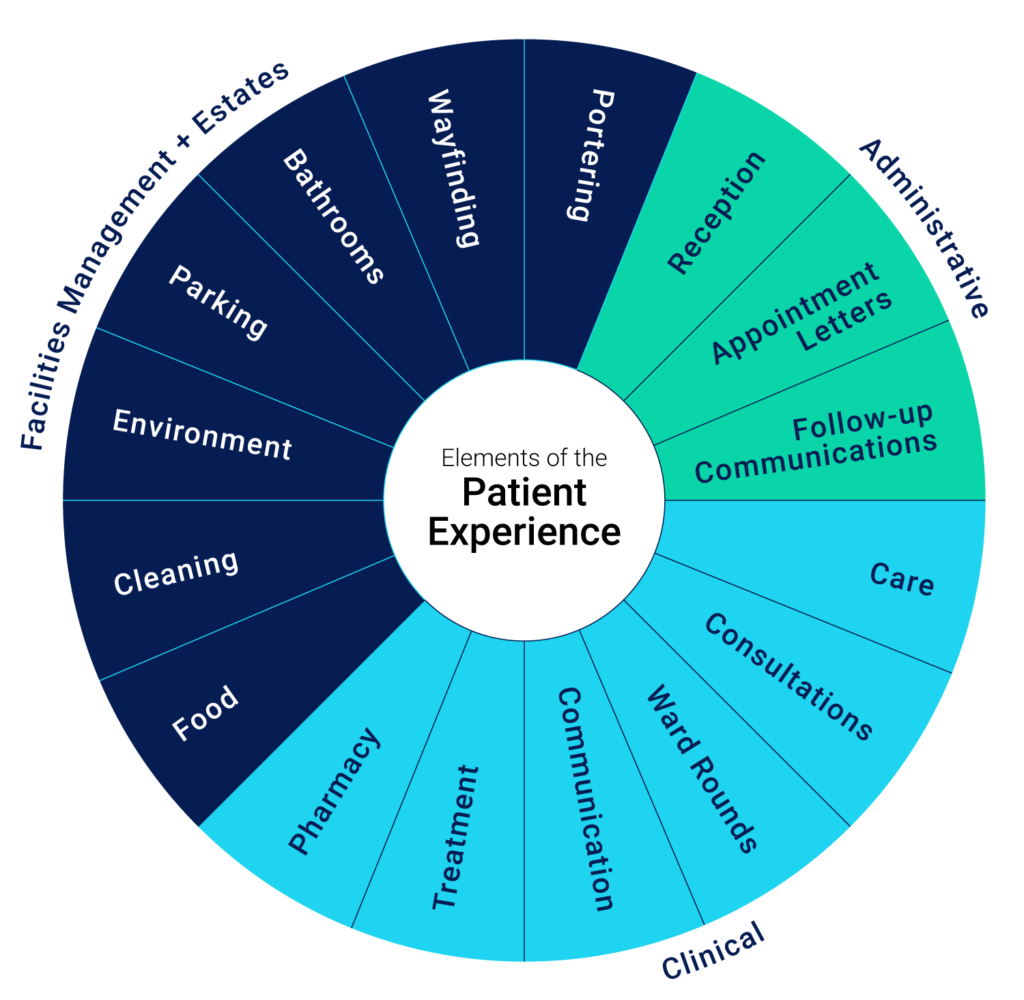
The medical profession is one that requires face-to-face interactions with patients on a daily basis. However, it’s not just the physician who’s responsible for creating a positive patient experience. The medical organization itself has a lot to do with how satisfied patients are, including facilitating a positive patient experience. Healthcare organizations should strive to provide an all-around positive experience for various reasons, from patient retention to improved staff morale. Determining how well your organization is performing within the patient’s perception first requires an understanding of the patient experience, how it differs from patient satisfaction and how to improve it, if and when necessary.
What Is Patient Experience?
“Patient experience” is a broadly used phrase with different meanings amongst different healthcare organizations. Unfortunately, there isn’t one standard definition, which can make it difficult to provide and measure. The Beryl Institute breaks down the multifaceted concept of patient experience into four critical themes: personal interactions, the organization’s culture, patient and family perceptions and the continuum of care.
The patient experience encompasses a wide range of interactions patients have within the healthcare system, with doctors, nurses and staff at hospitals, physician practices or other healthcare facilities. Patients place a lot of value on their experience when receiving care, such as whether appointments are timely, they’re provided with easy access to their health information and if healthcare providers are good at communicating necessary information.
For any organization looking to provide more patient-centered care, patient experience is essential. You need to be aware of the level of respectful, responsive care each patient receives. This includes how well the patient’s needs are met and values respected, as well as how much the health system values patient safety and effective care. For larger organizations, this information can be gauged through surveys and questionnaires, such as the Hospital Consumer Assessment of Healthcare Providers and Systems (HCAHPS).
The Difference Between Patient Experience + Patient Satisfaction
While they sound similar (and are often used interchangeably), the patient experience is a different concept than patient satisfaction. Here are the key differences:
- Patient satisfaction: Assesses whether a patient’s expectations regarding the healthcare visit were met. This can vary per patient based on their unique expectations as to how care should be delivered.
- Patient experience: Determines whether specific, expected actions were taken during each visit or appointment, such as receiving clear communication or detailed instructions from the healthcare professionals before leaving, or being greeted by a staff member upon walking into the office.
While both play into creating a positive visit for patients, creating a positive patient experience is much more about determining set experience standards everyone should follow and doesn’t necessarily change based on treatments or reason for visiting.
Why Patient Experience Matters
Although the health system exists to help people, stepping into a healthcare setting can often make people anxious and uncomfortable. Creating a positive patient experience can do so much to help alleviate this and provide the following benefits:
- Better patient safety, improved clinical outcomes and higher patient satisfaction scores
- Shorter hospital stays and reduced readmissions
- Greater equity in access to care (i.e., translation services, offering specific-needs support, etc.)
- Improved staff morale and motivation leading to improved recruitment and retention
- Greater patient engagement and empowerment related to their own healthcare
- Reduced risks within the office, hospital, etc. (i.e., effective cleaning and maintenance to reduce or remove slip and trip hazards)
Patients who have a positive experience will generally feel more comfortable and less anxious during their visit, allowing for better engagement when discussing their health and care, supporting a better patient outcome.
Influential Factors for Patient Experience
Doctors and nurses are typically the ones with the most patient interaction on a daily basis. Still, when patients come in, they’re noticing much more — is the facility clean and maintained? Are administrative staff courteous and informative? Is the billing department helpful when questioned about affording patient care?
Obviously, the physician-patient relationship is an essential piece for a positive patient experience as they take charge of providing treatment options, preventative plans and discharge instructions. But those behind the scenes can help — or hinder — the overall patient care experience, even after a positive interaction with medical staff. These can include:
- Administration: Reception, appointment letters, follow-up communications
- Facilities Management: Food, cleaning, environment, parking, bathrooms
- Clinical: Pharmacy, treatment, ward rounds, consultations, care delivery

Top Causes of Negative Patient Experience
If you find your organization is lacking in patient experience, there are a few common causes that could be to blame. While the following aren’t the only possible contributors to a negative patient experience, they should be the first places to review when looking to make improvements.
Limited Resources
When physicians have limited resources at their disposal, it can make practicing efficiently more difficult and leave patients with less options for care access. Are patients offered various ways to contact medical staff, such as over the phone, through a patient portal or via email? Are accessibility and diversity needs met such as language options and available primary and urgent care locations? How is the phone system handled? Can patients reach a person right away, or do they need to be processed through a call center or machine service? Can patients easily pay their medical bills online, over the phone or in-office? Doctors and medical staff are unable to provide the level of care they need if patients are unable to reach them in the first place.
Resistance to Change
Healthcare is a quickly evolving concept, constantly introducing new technologies and new processes. If at any point, anyone from a single nurse to the entire organization, resists necessary workflow changes, it can quickly sour the patient experience. Resistance to change can result in care delays, poor record-keeping and even an inability to collect payments for medical care effectively. If and when a new process is introduced, staff must be thoroughly trained on how to use it properly and attention must be given to ensure everyone follows the process.
Lack of Awareness
When it comes to patient care and services, there are a variety of options available to get the most out of their care. However, if medical staff are unaware of available services, patients aren’t getting access to the best healthcare support they can. A physician’s lack of awareness of available patient services could be limiting the usage of things like remote monitoring offered by pharmaceutical companies. Physicians should be educated about all available avenues of care, and patients should be offered any potential solutions that may be helpful for them.
Complex Healthcare System
Anytime complexities are introduced, the process becomes more difficult from start to finish. Patients need to be presented with a straightforward process, from making an appointment to receiving treatments and paying the bills. If they’re given the runaround regarding how to complete their care, it’s going to create a negative patient experience. No one likes to feel like they aren’t receiving a straight answer or as if they are being tossed around to different contacts to repeatedly retell their story, only to be directed elsewhere again. Processes should be examined to ensure they’re as straightforward and direct as possible.
Health Disparities
Empathy is important in healthcare, but disparities can indicate a lack of empathy for specific groups of people, whether due to socioeconomic status, ethnicity, gender, age, disability or sexual orientation. If the medical or administrative staff at any level of the health system lack empathy for particular groups of patients, their concerns and symptoms could be dismissed, leaving them without the answers or treatments they need, leading to a poor patient experience. Everyone should treat each patient fairly and provide the same, high level of care regardless of their demographics.

Strategies for Improving Overall Patient Experience
A poor patient experience shouldn’t be ignored. Healthcare professionals and organizations should always be looking to maintain and improve patient experience. Thankfully, there are strategies you can implement to improve it.
- Maximize efficiencies to prevent delays or patient wait times by assessing your current operational and patient flow.
- Focus on empathy through effective, caring and compassionate communication.
- Listen to patients without interrupting.
- Assure patients understand their treatment plan once discussed.
- Overestimate the time it will take for evaluation and diagnosis, and over-deliver by accomplishing it more efficiently.
- Keep patients informed if/when delays occur.
- Address any patient anxieties and help them feel at ease and more comfortable.
- Utilize the “teach-back method” when providing discharge instructions to confirm the patient’s knowledge.
- Modernize patient access with more digital touchpoints.
- Don’t forget about the wellness and morale of your staff and units — happy staff equates to happy patients.
Improve Patient Experience With Improved Revenue Cycle Management
Creating a positive patient experience is absolutely essential, from patient safety to healthcare quality. While the staff has a big role to play, so do the processes your organization has in place. One excellent way of improving the patient experience is by having an improved revenue cycle management process and with the help of Ensemble Health Partners, you can easily put your focus back on patients — not on their payments.

